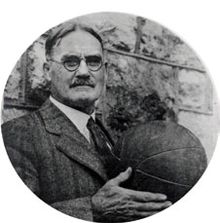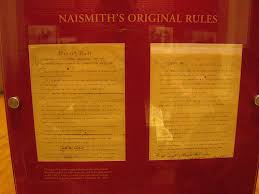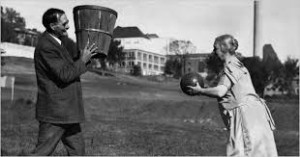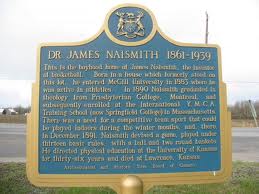 Respect for the inventor is unique to basketball. Even today, 123 years after Dr. James Naismith composed a list of 13 rules and supervised the first basketball game in history, it is not unusual for someone to say something like: “That’s the way Dr. Naismith intended the game to be played,” a statement that would likely amuse a man universally praised for his surpassing intelligence and uncommon humility.
Respect for the inventor is unique to basketball. Even today, 123 years after Dr. James Naismith composed a list of 13 rules and supervised the first basketball game in history, it is not unusual for someone to say something like: “That’s the way Dr. Naismith intended the game to be played,” a statement that would likely amuse a man universally praised for his surpassing intelligence and uncommon humility.
You never hear “that’s the way (whoever) wanted (baseball or football) to be played,” in part because no one person is given credit for either. Walter Camp is called the “Father of American Football” because he developed rule changes that had a huge impact on the game, but no one ever says teams “should play football the way Walter Camp intended.”
 Basketball, however, has a clear beginning with Naismith and it’s always fascinating, particularly on basketball’s birthday, to speculate on what Naismith would think of his game today. It is also interesting to know what those who were affected by Naismith’s invention might think. For example, the first game was played on Dec. 21, 1891, in Springfield, Massachusetts, and the final score was 1-0. The only basket was made by a man named William R. Chase.
Basketball, however, has a clear beginning with Naismith and it’s always fascinating, particularly on basketball’s birthday, to speculate on what Naismith would think of his game today. It is also interesting to know what those who were affected by Naismith’s invention might think. For example, the first game was played on Dec. 21, 1891, in Springfield, Massachusetts, and the final score was 1-0. The only basket was made by a man named William R. Chase.
If he were still alive – yes, I know, he’d be pushing 150 but we’ll ask for a little leeway here – I’m thinking an interview with Chase would go something like this:
Question: What was it like playing in that first game?
William R. Chase: We hated it.
Q: Why?
WRC: Naismith had tried several new indoor games and they were all boring. They were trying to keep us busy during the winter months when it was too cold to play football or rugby or other sports where we could beat the hell out of each other.
Q: Why did you want to do that?
WRC: We were men. You know, testosterone.
Q: Wasn’t the first game physical?
WRC: No. It was designed as a non-contact sport. The rules were “no shouldering, holding, pushing, tripping or striking in any way the person of an opponent.”
Q: You guys eventually figured out a way around it, didn’t you?
 WRC: Everybody did. It started almost right away and eventually it got so bad that when Naismith went to a Kansas-Missouri game in 1910, they were battering each other and Naismith yelled: “Oh my gracious! They are murdering my game!”
WRC: Everybody did. It started almost right away and eventually it got so bad that when Naismith went to a Kansas-Missouri game in 1910, they were battering each other and Naismith yelled: “Oh my gracious! They are murdering my game!”
Q: Obviously they weren’t playing the game the way Naismith intended and he didn’t find that funny. But was there anything attributed to him that he did find amusing?
WRC: Yes, the Olympic press conference in 1996 in Atlanta when the reporter said to Karl Malone, “I am from Denmark and new to this business. How come you get two points every time you score?” And Malone said, “Dr. Naismith, when he invented the game, said two points.”
Q: Did that bother you?
WRC: Yes. Baskets originally were worth one point. I scored the first basket in history so I should know.
Q: Let’s get back to the first game. How did it compare to today’s game?
WRC: Vastly different. First, early on, the name of the game was Basket Ball. It did not become one word until 1921. There were 18 guys in the class so we had nine on each team. Naismith thought there could be as many as 40 on each side. Obviously the actual ball had not been invented, so we used a soccer ball.
Q: What else?
WRC: As you know, we used a peach basket with no hole in the bottom. When I made the shot, a custodian got a ladder and got the ball out of the basket. There were no backboards, no boundary lines, no lanes, no frontcourt or backcourt and baskets were worth, obviously, one point.
 Q: What was the length of the court?
Q: What was the length of the court?
WRC: About 55 feet.
Q: How far was your shot?
WRC: About mid court.
Q: A 3-pointer?
WRC: You got it. Perfect, eh?
Q: If you read them today, some of those 13 rules are pretty remarkable. Which do you think is the most impressive?
WRC: Rule No. 8. “A goal shall be made when the ball is thrown or batted from the grounds into the basket and stays there, providing those defending the goal do not touch or disturb the goal. If the ball rests on the edges, and the opponent moves the basket, it shall count as a goal.” At that point, with no concept of an athlete who could actually jump high enough to touch the edge of a basket, Naismith made up a rule covering basket interference and goaltending.
Q: What would surprise basketball fans the most?
WRC: There was no dribbling. You either had to pass the ball to another teammate or you could tip it in the air and keep tipping it to yourself as long as it was above your head.
Q: How did dribbling start?
WRC: If a player dropped a ball, he could pick it back up. So they kept on dropping the ball and picking it up, dropping and picking it up, in effect bouncing it to themselves. That led to dribbling.
Q: How did Naismith feel about that?
WRC: He loved it. In his book, he wrote that dribbling is “one of the most spectacular and exciting maneuvers in basketball.”
Q: Were there changes he did not like?
WRC: Yes. In the original game, after each basket, there was a jump ball. When the administrators who were in charge of the rules of the game changed it in 1936, Naismith said: “Personally, I feel the center jump is to basketball what the kickoff is to football. To award the ball to a team after a goal is scored takes away much of the thrill that is present in an opening play.”
 Q: Don’t you also find it amazing that Naismith put the basket 10 feet off the floor?
Q: Don’t you also find it amazing that Naismith put the basket 10 feet off the floor?
WRC: Not at all.
Q: Why?
WRC: Unlike other sports, Naismith knew the basket had to be off the floor because if it was on the floor, everyone would congregate around the goal and we’d beat the hell out of each other. So he had it nailed on the railing around the court and that happened to be 10 feet high.
Q: So the 10-foot basket was not his idea?
WRC: If the railing had been 11 feet high, the basket would have been 11 feet.
Q: Basketball was his most famous accomplishment, but Naismith was pretty fascinating, wasn’t he?
WRC: Yes, he was 30 when he invented basketball, but his mind never stopped working. He earned a degree in medicine seven years later. Later he became an ordained minister and when he was in his 50s, he enlisted in the Army as a chaplain. He spent time in France during World War I and in Texas during the Border War between the U.S. and Mexico. And as I’m sure you know, he invented the football helmet.
Q: Don’t you find it kind of amusing that he is the only coach in Kansas University history to have a losing record (55-60).
WRC: As a basketball coach, he was a great inventor.
Q: What would he think about the game today?
WRC: He’d love watching it – except, maybe, for the Knicks and Sixers.
Q: What would he think of the global appeal of the sport?
WRC: Well, he saw some of that. When basketball was first played in the Olympics in 1936, he was there to watch.
Q: Would he be surprised to watch someone like Dirk Nowitzki?
WRC: A 7-footer who can’t jump but is one of the greatest shooters ever? He’d be amazed.
Q: What about Dirk learning basketball in Germany?
WRC: I don’t think that would surprise him. Remember, Dr. Naismith was Canadian, although he later became a U.S. citizen.
Q: So would his favorite player be Steve Nash?
WRC: Favorite old player. Favorite young one would be Andrew Wiggins.
Q: So his favorite team would be Toronto?
WRC: Nope. The Spurs.
Q: Why?
WRC: Because they play the game the way Dr. Naismith intended.
Jan Hubbard has written about basketball since 1976 and worked in the NBA league office for eight years between media stints. Follow him on Twitter at @whyhub.
MAGIC, LIKE MICHAEL, HAS A COMPETITION PROBLEM
TANKING USED TO BE SO MUCH MORE FUN
LAKERS ARE ALL KOBE, ALL THE TIME
DIRK NOWITZKI-LARRY BIRD: STILL NOT A VALID COMPARISON
MICHELE ROBERTS’ POSTURING REMINISCENT OF STERN
KYRIE WILL FIND OUT THAT LeBRON IS GOOD AT SHARING
SHOULD HARDEN TRADE STILL BE CURSED FOR THUNDER?
LAKERS ARE WORTHY OF, AHEM, PRIME TIME
A 44-MINUTE GAME? WHAT WOULD WILT SAY?
SMART MONEY IS ON THE SPURS
I need the authors name to reference!!!!!!!!!! Help me! ERGENT!!!!!!!!!!!!!!! bunny’s are fluffy!